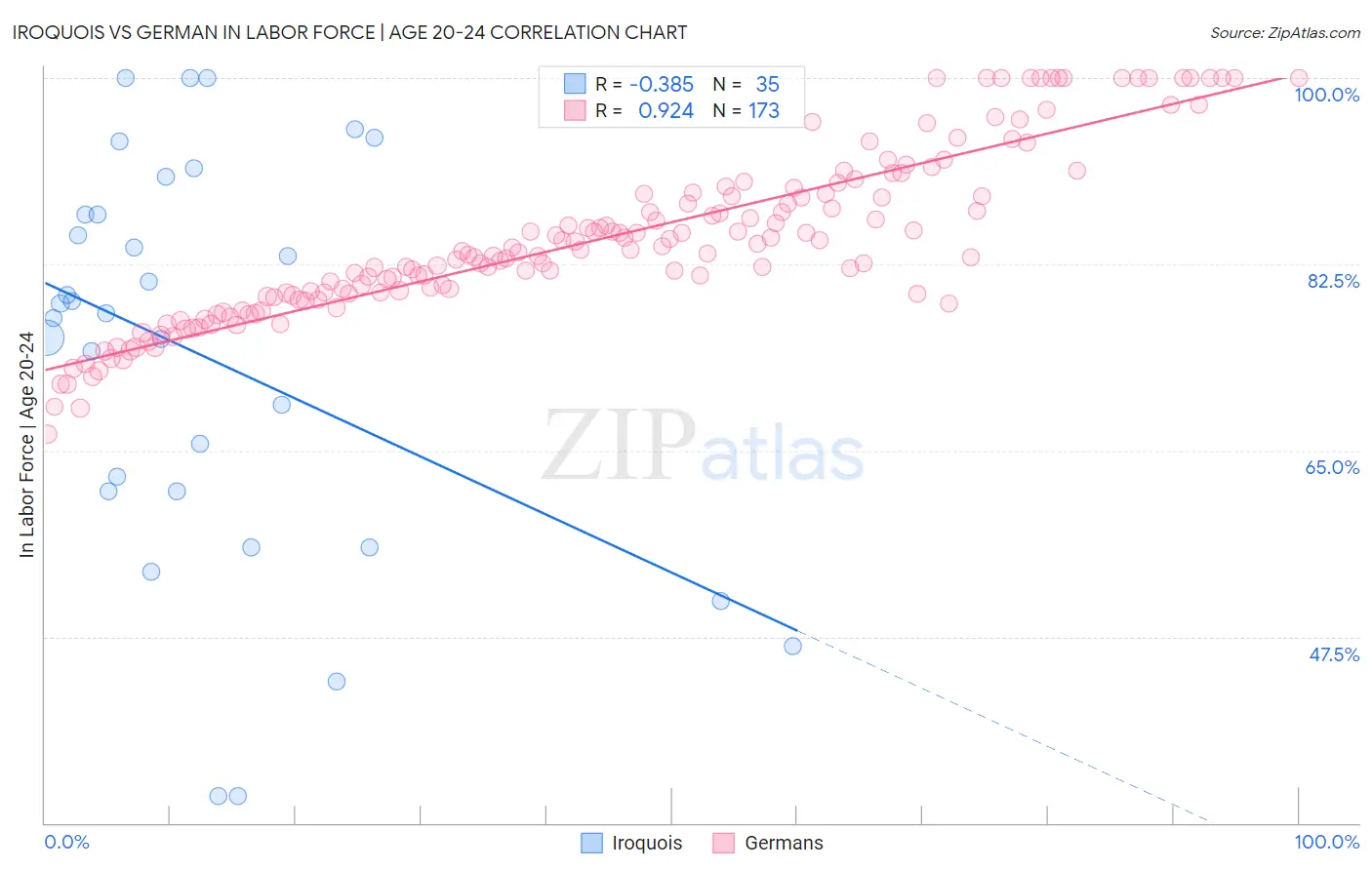Iroquois vs German In Labor Force | Age 20-24
COMPARE
Iroquois
German
In Labor Force | Age 20-24
In Labor Force | Age 20-24 Comparison
Iroquois
Germans
75.6%
IN LABOR FORCE | AGE 20-24
89.1/ 100
METRIC RATING
129th/ 347
METRIC RANK
78.6%
IN LABOR FORCE | AGE 20-24
100.0/ 100
METRIC RATING
12th/ 347
METRIC RANK
Iroquois vs German In Labor Force | Age 20-24 Correlation Chart
The statistical analysis conducted on geographies consisting of 207,263,763 people shows a mild negative correlation between the proportion of Iroquois and labor force participation rate among population between the ages 20 and 24 in the United States with a correlation coefficient (R) of -0.385 and weighted average of 75.6%. Similarly, the statistical analysis conducted on geographies consisting of 578,744,060 people shows a near-perfect positive correlation between the proportion of Germans and labor force participation rate among population between the ages 20 and 24 in the United States with a correlation coefficient (R) of 0.924 and weighted average of 78.6%, a difference of 3.9%.

In Labor Force | Age 20-24 Correlation Summary
| Measurement | Iroquois | German |
| Minimum | 32.5% | 66.5% |
| Maximum | 100.0% | 100.0% |
| Range | 67.5% | 33.5% |
| Mean | 73.8% | 84.7% |
| Median | 77.9% | 83.6% |
| Interquartile 25% (IQ1) | 61.2% | 79.5% |
| Interquartile 75% (IQ3) | 87.2% | 89.1% |
| Interquartile Range (IQR) | 26.0% | 9.6% |
| Standard Deviation (Sample) | 18.8% | 7.8% |
| Standard Deviation (Population) | 18.5% | 7.8% |
Similar Demographics by In Labor Force | Age 20-24
Demographics Similar to Iroquois by In Labor Force | Age 20-24
In terms of in labor force | age 20-24, the demographic groups most similar to Iroquois are Immigrants from Afghanistan (75.6%, a difference of 0.010%), Immigrants from Austria (75.6%, a difference of 0.010%), Immigrants from Jordan (75.6%, a difference of 0.020%), Palestinian (75.6%, a difference of 0.020%), and Zimbabwean (75.6%, a difference of 0.030%).
| Demographics | Rating | Rank | In Labor Force | Age 20-24 |
| Pakistanis | 94.1 /100 | #122 | Exceptional 75.8% |
| Immigrants | Bulgaria | 94.1 /100 | #123 | Exceptional 75.8% |
| Immigrants | Sierra Leone | 93.8 /100 | #124 | Exceptional 75.8% |
| Immigrants | Scotland | 93.7 /100 | #125 | Exceptional 75.8% |
| Brazilians | 93.0 /100 | #126 | Exceptional 75.8% |
| Sub-Saharan Africans | 90.9 /100 | #127 | Exceptional 75.7% |
| Immigrants | Afghanistan | 89.4 /100 | #128 | Excellent 75.6% |
| Iroquois | 89.1 /100 | #129 | Excellent 75.6% |
| Immigrants | Austria | 88.8 /100 | #130 | Excellent 75.6% |
| Immigrants | Jordan | 88.5 /100 | #131 | Excellent 75.6% |
| Palestinians | 88.4 /100 | #132 | Excellent 75.6% |
| Zimbabweans | 88.2 /100 | #133 | Excellent 75.6% |
| Estonians | 87.1 /100 | #134 | Excellent 75.6% |
| Yaqui | 85.5 /100 | #135 | Excellent 75.5% |
| Immigrants | Brazil | 84.8 /100 | #136 | Excellent 75.5% |
Demographics Similar to Germans by In Labor Force | Age 20-24
In terms of in labor force | age 20-24, the demographic groups most similar to Germans are Scandinavian (78.5%, a difference of 0.070%), Czech (78.5%, a difference of 0.070%), Finnish (78.7%, a difference of 0.11%), Slovene (78.7%, a difference of 0.15%), and Sudanese (78.4%, a difference of 0.21%).
| Demographics | Rating | Rank | In Labor Force | Age 20-24 |
| Aleuts | 100.0 /100 | #5 | Exceptional 79.0% |
| Danes | 100.0 /100 | #6 | Exceptional 79.0% |
| Luxembourgers | 100.0 /100 | #7 | Exceptional 79.0% |
| Immigrants | Cabo Verde | 100.0 /100 | #8 | Exceptional 78.9% |
| Swedes | 100.0 /100 | #9 | Exceptional 78.8% |
| Slovenes | 100.0 /100 | #10 | Exceptional 78.7% |
| Finns | 100.0 /100 | #11 | Exceptional 78.7% |
| Germans | 100.0 /100 | #12 | Exceptional 78.6% |
| Scandinavians | 100.0 /100 | #13 | Exceptional 78.5% |
| Czechs | 100.0 /100 | #14 | Exceptional 78.5% |
| Sudanese | 100.0 /100 | #15 | Exceptional 78.4% |
| Dutch | 100.0 /100 | #16 | Exceptional 78.4% |
| Cape Verdeans | 100.0 /100 | #17 | Exceptional 78.3% |
| Immigrants | Bosnia and Herzegovina | 100.0 /100 | #18 | Exceptional 78.1% |
| Bangladeshis | 100.0 /100 | #19 | Exceptional 78.1% |